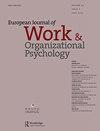The effect of time and day of the week on burnout-related experiences: an experience sampling study
IF 3.4
2区 心理学
Q2 MANAGEMENT
European Journal of Work and Organizational Psychology
Pub Date : 2023-10-13
DOI:10.1080/1359432x.2023.2266874
引用次数: 0
Abstract
Burnout has traditionally been characterized as a relatively stable construct, leaving the question of whether and how burnout-related experiences fluctuate within and between days unaddressed. In the current study, we assess the effect of time of day (expressed as external time, internal time, or time awake) and day of the week on momentary experiences of the two core components of burnout, i.e., exhaustion and disengagement. We employed a 7-day experience sampling method in the field among 65 working employees, with seven momentary assessments per day. Results indicated that a large proportion of variance in burnout-related experiences occurred between moments (46%-68%), with only minor variance occurring between days within participants (2%-6%). Notably, experiences related to the disengagement component showed no clear pattern over the day, while exhaustion remained relatively stable throughout the morning and then increased moderately towards the end of the day. We conclude that burnout-related experiences typically fluctuate between moments, supporting the view of burnout as a dynamic rather than a purely static state. Furthermore, much of the variance in momentary burnout-related experiences remains to be explained in absence of a structural temporal pattern.时间和星期对倦怠相关经验的影响:经验抽样研究
职业倦怠传统上被认为是一个相对稳定的概念,这就留下了一个问题,即与职业倦怠相关的经历是否以及如何在几天内和几天之间波动。在本研究中,我们评估了一天中的时间(表达为外部时间,内部时间或清醒时间)和一周中的一天对倦怠的两个核心组成部分的瞬间体验的影响,即疲惫和脱离。我们在65名在职员工中采用了为期7天的现场经验抽样方法,每天进行7次瞬时评估。结果表明,与倦怠相关的经历的很大一部分差异发生在时刻之间(46%-68%),而参与者之间的天之间只有较小的差异(2%-6%)。值得注意的是,与脱离接触部分相关的体验在一天中没有明显的模式,而疲惫在整个上午保持相对稳定,然后在一天结束时适度增加。我们的结论是,与倦怠相关的经历通常在不同的时刻之间波动,这支持了倦怠是一种动态状态而非纯粹静态状态的观点。此外,在缺乏结构性时间模式的情况下,与瞬间倦怠相关的经历的许多差异仍有待解释。
本文章由计算机程序翻译,如有差异,请以英文原文为准。
求助全文
约1分钟内获得全文
求助全文
来源期刊
CiteScore
8.00
自引率
2.30%
发文量
40
期刊介绍:
The mission of the European Journal of Work and Organizational Psychology is to promote and support the development of Work and Organizational Psychology by publishing high-quality scientific articles that improve our understanding of phenomena occurring in work and organizational settings. The journal publishes empirical, theoretical, methodological, and review articles that are relevant to real-world situations. The journal has a world-wide authorship, readership and editorial board. Submissions from all around the world are invited.

 求助内容:
求助内容: 应助结果提醒方式:
应助结果提醒方式:


